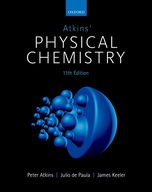?This and the following problem explore quantitatively the spectra of molecular solids
Chapter 15, Problem P15G.1(choose chapter or problem)
This and the following problem explore quantitatively the spectra of molecular solids. First consider a dimer formed from two identical monomers. For the first monomer, the normalized ground state wavefunction is \(\psi_{a}(1)\) and the normalized excited state wavefunction is \(\psi_{b}(1)\); for the second monomer the wavefunctions are \(\psi_{a}(2)\) and \(\psi_{b}(2)\)-the label in parenthesis identifies to which monomer the wavefunction refers, but otherwise \(\psi_{a}\) and \(\psi_{b}\) are the same for each monomer. In each monomer there is a transition between \(\psi_{a}\) and \(\psi_{b}\) with transition dipole moment \(\mu_{\text {mon }}\) and wavenumber \(\tilde{v}_{\text {mon. }}\). For convenience the energy of the ground state is taken as zero, so the energy of the excited state, expressed as a wavenumber, is \(\tilde{v}_{\text {mon }}\). It is assumed that dimerization does not affect the ground state wavefunctions, but the excited state wavefunctions become mixed so the excited state of the dimer has wavefunctions \(\Psi_{\pm}=c_{1, \pm} \psi_{b}(1)+c_{2, \pm} \psi_{b}\) (2); the mixing of the two monomer wavefunctions gives two dimer wavefunctions, denoted \(\Psi_{\pm}\), the coefficients \(c_{i, \pm}\) are to be determined. In the basis \(\psi_{b}(1), \psi_{b}(2)\) the hamiltonian matrix has the form
\(\hat{H}=\left(\begin{array}{cc} \tilde{v}_{\text {mon }} & \tilde{\beta} \\ \tilde{\beta} & \tilde{v}_{\text {mon }} \end{array}\right)\)
The diagonal elements are the energies (as a wavenumber) of the excited state of the monomer. The off-diagonal elements correspond to the energy of interaction between the transition dipoles. Using the arrangement illustrated in (1) of Topic 15G, this interaction energy (as a wavenumber) is:
\(\tilde{\beta}=\frac{\mu_{\text {mon }}^{2}}{4 \pi \varepsilon_{0} h c r^{3}}\left(1-3 \cos ^{2} \theta\right)\)
The eigenvectors of the hamiltonian matrix are the wavefunctions for the excited state of the dimer, and these can be written \(\left(\begin{array}{c}c_{1, \pm} \\ c_{2, \pm}\end{array}\right)\). The eigenvalues are the energies corresponding to these wavefunctions, and because it has been assumed that the ground states of the dimer are the same as for the monomer, these energies will correspond to the transitions in the dimer.
(a) Show that \(\left(\begin{array}{l}1 \\ 1\end{array}\right)\) and \(\left(\begin{array}{c}1 \\ -1\end{array}\right)\) are eigenvectors of the hamiltonian matrix and that the corresponding eigenvalues are \(\tilde{v}_{\pm}=\tilde{v}_{\text {mon }} \pm \tilde{\beta}\).
(b) The first eigenvector corresponds to writing the wavefunction as \(\Psi_{+}=c_{1,+} \psi_{b}(1)+c_{2,+} \psi_{b}(2)=\psi_{b}(1)+\psi_{b}(2)\). Normalize the wavefunction, assuming that \(S=\int \psi_{b}^{\star}(1) \psi_{b}(2) \mathrm{d} \tau\); do the same for the second eigenvector, which corresponds to \(\Psi_{-}=\psi_{b}(1)-\psi_{b}(2)\).
(c) The monomer transition dipole moment is \(\mu_{\text {mon }}=\int \psi_{b}^{\star}(1) \hat{\mu} \psi_{a}(1) \mathrm{d} \tau=\int \psi_{b}^{\star}(2) \hat{\mu} \psi_{a}(2) \mathrm{d} \tau\). For the dimer the transition moment is \(\mu_{\mathrm{dim}}=\int \Psi_{\pm}^{\star} \hat{\mu} \Psi_{0} \mathrm{~d} \tau\), where \(\Psi_{0}\) is the wavefunction of the dimer ground state. Because it is assumed that there is no interaction between the ground-state wavefunctions of the dimer, \(\Psi_{0}\) can be written as \(\left(1 / 2^{1 / 2}\right)\left(\psi_{a}(1)+\psi_{a}(2)\right)\). Find expressions for \(\mu_{\operatorname{dim}}\) for the two excited state wavefunctions, \(\Psi_{\pm}\). In solving this problem it is helpful to realize that it is closely analogous to the overlap of two atomic orbitals to give molecular orbitals (Topic 9E).
Text Transcription:
psi_a(1)
psi_b(1)
psi_a(2
psi_b(2)
psi_a
psi_b
mu_mon
tilde v_mon
Psi_pm=c_1, pm psi_b(1)+c_2, pm psi_b
Psi_p
c_i, pm
psi_b(1), psi_b(2)
hatH=(tilde v_mon tilde beta tilde beta tilde v_mon)
tilde beta=mu_mon^2/4 pi varepsilon_0 hcr^3(1-3 cos^2 theta)
(c_1, pm \\ c_2, pm)
(l1 \\ 1)(c1 \\ -1)
tilde v_pm=tilde v_mon pm tilde beta
Psi_+=c_1,+ psi_b(1)+c_2,+ psi_b(2)=psi_b(1)+psi_b(2)
S=int psi_b^star(1) psi_b(2) d tau
Psi_-=psi_b(1)-psi_b(2)
mu_mon=int psi_b^star(1) hatmu psi_a(1) d tau=int psi_b^star(2) hat mu psi_a(2) d tau
mu_dim=int Psi_pm^star hat mu Psi_0 d tau
Psi_0
Psi_0
(1/2^1/2)(psi_a(1)+psi_a(2)
mu_dim
Psi_pm
Unfortunately, we don't have that question answered yet. But you can get it answered in just 5 hours by Logging in or Becoming a subscriber.
Becoming a subscriber
Or look for another answer
